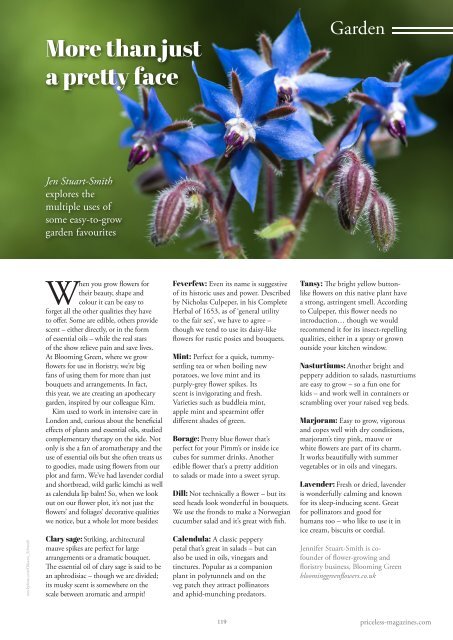Wealden Times | WT265 | June 2024 | Education Supplement inside
The lifestyle magazine for Kent & Sussex - Inspirational Interiors, Fabulous Fashion, Delicious Dishes
The lifestyle magazine for Kent & Sussex - Inspirational Interiors, Fabulous Fashion, Delicious Dishes
Create successful ePaper yourself
Turn your PDF publications into a flip-book with our unique Google optimized e-Paper software.
More than just<br />
a pretty face<br />
Garden<br />
Jen Stuart-Smith<br />
explores the<br />
multiple uses of<br />
some easy-to-grow<br />
garden favourites<br />
istockphoto.com/Oksana_Schmidt<br />
When you grow flowers for<br />
their beauty, shape and<br />
colour it can be easy to<br />
forget all the other qualities they have<br />
to offer. Some are edible, others provide<br />
scent – either directly, or in the form<br />
of essential oils – while the real stars<br />
of the show relieve pain and save lives.<br />
At Blooming Green, where we grow<br />
flowers for use in floristry, we’re big<br />
fans of using them for more than just<br />
bouquets and arrangements. In fact,<br />
this year, we are creating an apothecary<br />
garden, inspired by our colleague Kim.<br />
Kim used to work in intensive care in<br />
London and, curious about the beneficial<br />
effects of plants and essential oils, studied<br />
complementary therapy on the side. Not<br />
only is she a fan of aromatherapy and the<br />
use of essential oils but she often treats us<br />
to goodies, made using flowers from our<br />
plot and farm. We’ve had lavender cordial<br />
and shortbread, wild garlic kimchi as well<br />
as calendula lip balm! So, when we look<br />
out on our flower plot, it’s not just the<br />
flowers’ and foliages’ decorative qualities<br />
we notice, but a whole lot more besides:<br />
Clary sage: Striking, architectural<br />
mauve spikes are perfect for large<br />
arrangements or a dramatic bouquet.<br />
The essential oil of clary sage is said to be<br />
an aphrodisiac – though we are divided;<br />
its musky scent is somewhere on the<br />
scale between aromatic and armpit!<br />
Feverfew: Even its name is suggestive<br />
of its historic uses and power. Described<br />
by Nicholas Culpeper, in his Complete<br />
Herbal of 1653, as of ‘general utility<br />
to the fair sex’, we have to agree –<br />
though we tend to use its daisy-like<br />
flowers for rustic posies and bouquets.<br />
Mint: Perfect for a quick, tummysettling<br />
tea or when boiling new<br />
potatoes, we love mint and its<br />
purply-grey flower spikes. Its<br />
scent is invigorating and fresh.<br />
Varieties such as buddleia mint,<br />
apple mint and spearmint offer<br />
different shades of green.<br />
Borage: Pretty blue flower that’s<br />
perfect for your Pimm’s or <strong>inside</strong> ice<br />
cubes for summer drinks. Another<br />
edible flower that’s a pretty addition<br />
to salads or made into a sweet syrup.<br />
Dill: Not technically a flower – but its<br />
seed heads look wonderful in bouquets.<br />
We use the fronds to make a Norwegian<br />
cucumber salad and it’s great with fish.<br />
Calendula: A classic peppery<br />
petal that’s great in salads – but can<br />
also be used in oils, vinegars and<br />
tinctures. Popular as a companion<br />
plant in polytunnels and on the<br />
veg patch they attract pollinators<br />
and aphid-munching predators.<br />
Tansy: The bright yellow buttonlike<br />
flowers on this native plant have<br />
a strong, astringent smell. According<br />
to Culpeper, this flower needs no<br />
introduction… though we would<br />
recommend it for its insect-repelling<br />
qualities, either in a spray or grown<br />
outside your kitchen window.<br />
Nasturtiums: Another bright and<br />
peppery addition to salads, nasturtiums<br />
are easy to grow – so a fun one for<br />
kids – and work well in containers or<br />
scrambling over your raised veg beds.<br />
Marjoram: Easy to grow, vigorous<br />
and copes well with dry conditions,<br />
marjoram’s tiny pink, mauve or<br />
white flowers are part of its charm.<br />
It works beautifully with summer<br />
vegetables or in oils and vinegars.<br />
Lavender: Fresh or dried, lavender<br />
is wonderfully calming and known<br />
for its sleep-inducing scent. Great<br />
for pollinators and good for<br />
humans too – who like to use it in<br />
ice cream, biscuits or cordial.<br />
Jennifer Stuart-Smith is cofounder<br />
of flower-growing and<br />
floristry business, Blooming Green<br />
bloominggreenflowers.co.uk<br />
119<br />
priceless-magazines.com

















